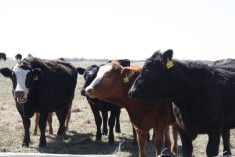This cattle market information is selected from the weekly report from Canfax, a division of the Canadian Cattlemen’s Association. More market information, analysis and statistics are available by becoming a Canfax subscriber by calling 403-275-5110 or at www.canfax.ca.
Fed prices down slightly
Alberta direct cattle sales saw dressed prices steady to $2 per hundredweight higher last week, but weighted average steer prices eased lower as a flush of fed calves hit the market with reduced yield expectations.
Read Also

Why feds imposed EV tariffs
Moe and Kinew have a fight on their hands when it comes to eliminating the EV tariff. Canada has to worry about pissing off the U.S. and Mexico and hundreds of thousands of auto workers.
Compared with the previous week, a few more cash cattle were procured further away from the packing plant, and f.o.b. the feedlot prices minus freight were slightly lower. Most weekly trade was reported dressed from $380-$382 per cwt. delivered for various May kill dates.
Western Canadian fed slaughter for the week ending April 22 firmed two percent larger than the previous week to 41,175 head. National and western steer carcass weights set new annual lows last week, down 12 lb. and 16 lb. from the previous week, respectively. At 872 lb., western Canadian steer weights were significantly 41 lb. lower than the same week last year.
Moderate volume Ontario trade was fully steady with the previous week at $375 per cwt. delivered.
Carcass weights are expected to trend seasonally lower and usually bottom in June. Fed prices typically soften from April to May as spring beef buying slows.
In the United States, scattered live trade in the south saw prices steady to US$3 per cwt. lower than the previous week from $171-$174.50 per cwt. Northern trade was generally $3-$4 per cwt. lower than the previous week, with live sales from $175-$180 per cwt., and dressed sales were in a tight $283-$285 per cwt. delivered trade range.
Cow prices high
Butcher cow prices have increased 13 percent over the past month. This is the third largest monthly price increase for April on record.
Seasonally lighter non-fed supplies continue to be met with good demand. Butcher cows traded $5-$6 per cwt. higher last week and are now within $5 per cwt. of their all-time highs set in spring 2015. D2s traded at $146.25 and D3s at $126.60 per cwt. Butcher bulls averaged $155.85.
Alberta cow prices are at a $6 per cwt. premium against the U.S. utility cow market. Year-to-date Canadian cow slaughter is nine percent larger than last year. The year-over-year increase is a little misleading because Canadian cow exports to the U.S. have been running well below last year.
From January to February, Canadian cow exports to the U.S. are down 23 percent compared to last year. For the first two months of this year, this is the smallest Canadian cow export volume since 2019.
Feeder prices strengthen
Over the past month, 600-900 lb. feeder prices have strengthened $10-$15 per cwt. Some grass operators have taken advantage of stronger prices and might be looking to reduce stocking rates in drier parts of Alberta by selling some grass cattle on the cash market.
Eastern Canadian feedlot demand continues to be strong on the Western Canadian market, showing particular interest on mid-weight steers. This time of the year, eastern buyers are usually more active on heavier weight steers and heifers.
Last week, Alberta 900 lb. and heavier steers for September delivery traded in the low $270s per cwt. On average, heifers for September delivery are trading roughly $10-$15 per cwt. less. The forward delivery calf market was lightly tested in the past few weeks. Alberta and Saskatchewan 700-weight steer calves for October delivery traded in the mid $290s per cwt.
On a monthly basis over the past six years, 750 lb. steer prices have been higher in October than in April. For April, Alberta 700-800 lb. steers are on track to average around $291 per cwt. Canadian feeder cattle exports to the U.S. totalled 4,917 head, the largest weekly export volume this year.
In bred cattle, some late-calving bred cows are coming to town. Last week, bred cows traded from $2,100-$2,500 per head. Demand for cows scheduled to calve in May or June was decent, but cows that won’t calve until late summer/early fall were going to slaughter.
Cow/calf pairs traded from $2,475-$3,350, averaging $2,750 per head. Younger cows with older calves at side traded at the top end of the range.
U.S. cutouts up
In U.S. beef trade, cutouts rallied higher to end last week. Choice cutouts closed US$4 per cwt. higher at $311.07, and Select cutouts were steady at $289.09 per cwt. The Choice/Select spread widened to $21.98 per cwt. on the strength of Choice cutouts.














